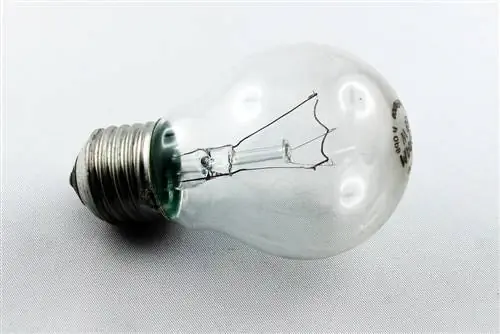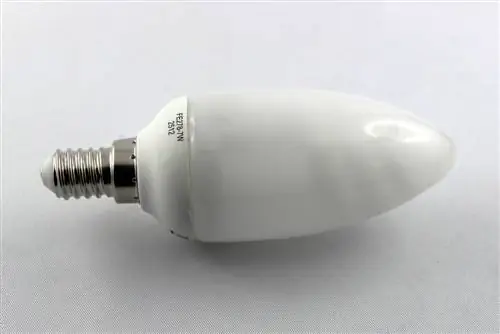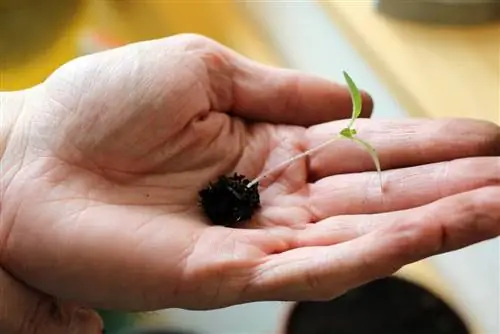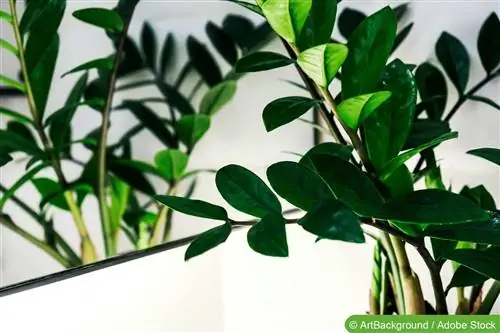- Author admin [email protected].
- Public 2024-01-15 02:39.
- Last modified 2025-06-01 06:48.
For a long time, the classic light bulb was the only light source on the market. The energy consumption was very high and was between ten and 100 watts. As a knowledgeable buyer, you knew which wattage roughly corresponds to which brightness. Since modern lighting requires much less energy, this calculation no longer works. A conversion to the new values is required.
The energy values of light bulbs
Classic light bulbs worked with a filament through which electricity flowed. The thread was so thin that the current through it heated it up and began to glow. Thanks to its special construction, the glowing thread turned into a light that could illuminate the room. The glow generated a lot of heat, the light bulb became hot, and this heat required a lot of energy. This high energy consumption was reflected in the wattage and at the same time determined the brightness. You could buy light bulbs with an output of up to 100 watts. Smaller versions, for example in the shape of a candle, did not provide as much brightness and had an output of only ten watts. Light bulbs with values of 40 and 60 watts were very popular. With the experience of buying light bulbs, you knew what wattage you needed to sufficiently light the room:
- 10 to 20 watts - dim, rather cozy lighting
- 40 watts - lighting for living spaces
- 60 Watt - reading lamps, kitchen lighting
- 80 to 100 watts - very bright light for reading and working

The classic light bulbs were banned by the EU a few years ago and replaced by energy-saving lamps and LED bulbs. These are significantly more expensive, but also have a longer lifespan. The filament of the light bulbs burned out after a certain time, while the light-emitting diode variant can have a lifespan of up to 100,000 hours. For classic light bulb buyers, however, not only the price but also the performance is associated with a reorientation. Since the new energy-saving lamps are much more energy efficient, the wattages have changed and must be converted if the brightness is to be determined.
Good to know:
Some manufacturers of modern light sources still work with the old wattages of light bulbs. This information is for your guidance only and to determine the brightness. The consumption of modern lamps is of course significantly lower.
The brightness in lumens
The brightness of a lamp is not specified in watts, but in lumens. The Watt size, on the other hand, indicates the power consumption. However, it was not common for the older light bulbs to work with lumens. For this reason, consumers made a connection between the brightness of light bulbs and the power consumption in watts. Determining the actual level of brightness in lumens has now become somewhat more important. However, out of habit, many customers still orientate themselves on the classic wattages and select the appropriate light bulb accordingly.
Energy-saving lamp as a successor to light bulbs
The light bulbs were banned not only because of their high power consumption, but also because of their environmental impact and were replaced by energy-saving lamps in the first few years. Today, this rather broad term encompasses a large number of light sources that have different optics and brightness. The size and shape of the sockets are adapted to those of the old standardized light bulbs, so that no new lamps had to be purchased. These are low-pressure lamps filled with mercury and can be dangerous if broken. Depending on the model, the service life is between 3,000 and 15,000 hours. The energy consumption is very low and results in the following values when converted:
- Light bulbs with 20 watts of power correspond to 4 watts of power for energy-saving lamps
- Bulbs with 40 watts of power correspond to 9 watts of power for energy-saving lamps
- Light bulbs with 60 watts of power correspond to 11 watts of power for energy-saving lamps
- Light bulbs with 100 watts of power correspond to 20 watts of power for energy-saving lamps
These are approximate values that can help you buy the right light bulb. You can see that the energy-saving lamp uses around a quarter to a fifth less electricity than classic light bulbs.
LED technology for modern lamps

In addition to energy-saving lamps, LED technology has proven to be the light source of the future. The enormous service life, which some manufacturers claim to be up to 100,000 hours, makes the lights very effective despite their comparatively high purchase costs. In terms of their appearance, the lights do not differ from a light bulb. The technology is completely different. Modern lamps work with phosphors that are coated with synthetic resin and applied to a special chip. If you invest in these lights, you will no longer need to buy new bulbs in the near future. The lamps do not burn out, but rather lose their luminosity over time. If the room is no longer illuminated enough, you need to make a change. However, you can use the lights for many years beforehand. It is also possible to convert the energy consumption for these lights in comparison with classic light bulbs and the known values:
- Light bulbs with 20 watts of power correspond to 3 - 4 watts of power
- Bulbs with 40 watts of power correspond to 6 - 8 watts of power
- Light bulbs with 60 watts of power correspond to 9 - 12 watts of power
- Light bulbs with 100 watts of power correspond to 18 - 19 watts of power
In comparison, you can see that the energy consumption of these lights is even lower than that of energy-saving lamps. Since the service life is significantly longer, you should invest in these lamps, even though they are more expensive to purchase than energy-saving lamps.
Tip:
Equip your house or apartment with LED lamps if you want to save energy and value a long lamp life.
Consumption of incandescent lamps and energy-saving lamps in comparison
| Lumen |
Consumption the energy saving lamp |
Consumption the light bulb |
| 150 In |
4 W | 20 W |
| 200 In | 5 W | 25 W |
| 250 In | 6 W | 30 W |
| 300 - 350 Im | 7 W | 35 W |
| 400 - 500 Im | 8/9 W | 40 W |
| 500 In | 10 W | 50 W |
| 550 - 700 Im | 11 W | 60 W |
| 800 In | 14 W | 65 W |
| 950 In | 17 W | 75 W |
| 1200 In | 20 W | 100W |
| 1500 In | 23 W | 120 W |






